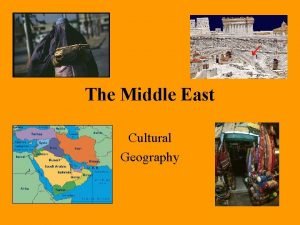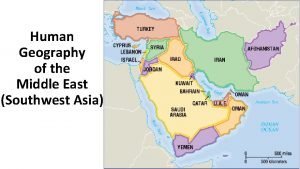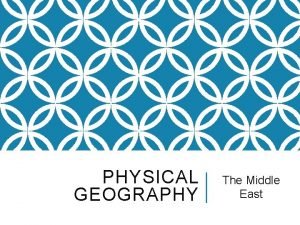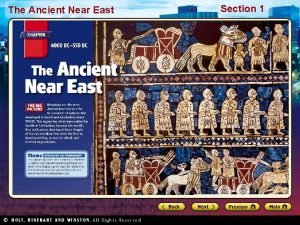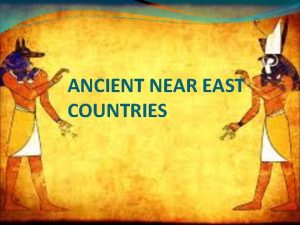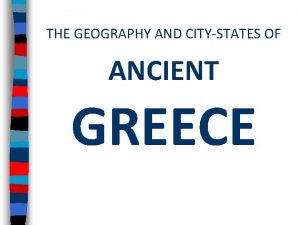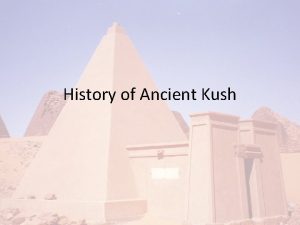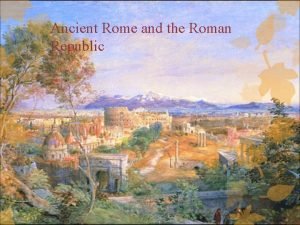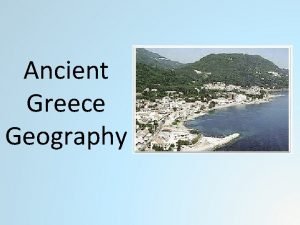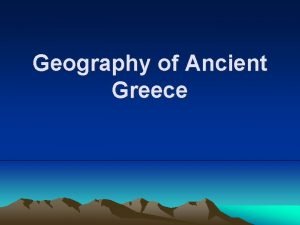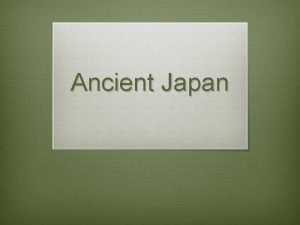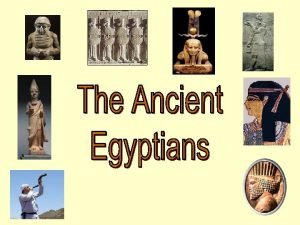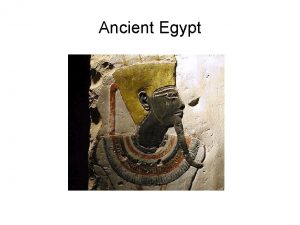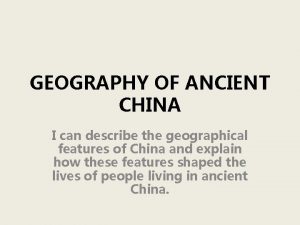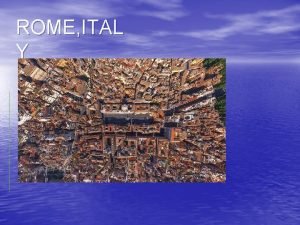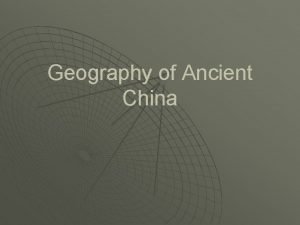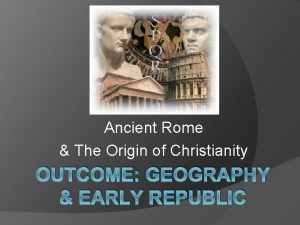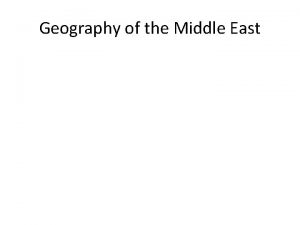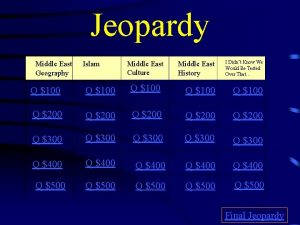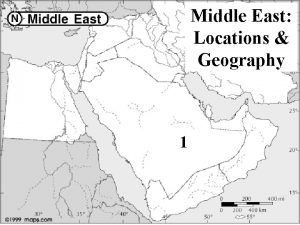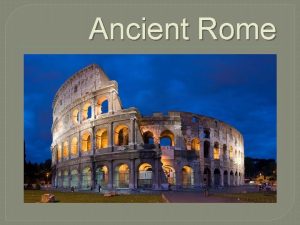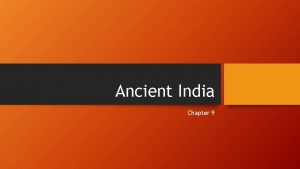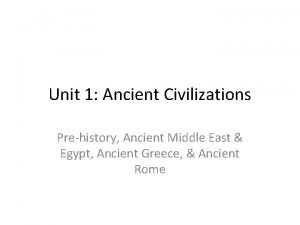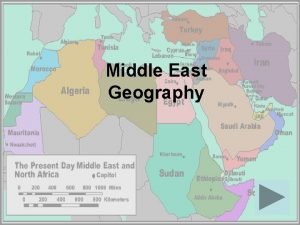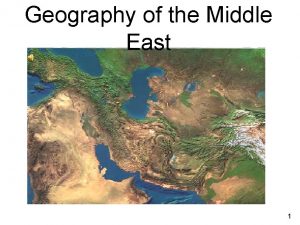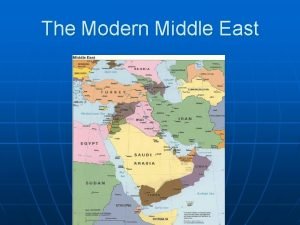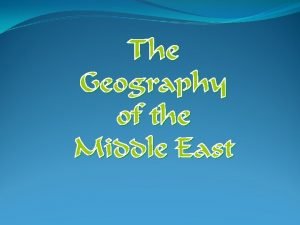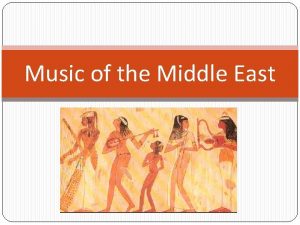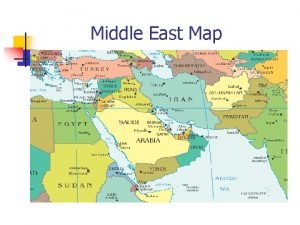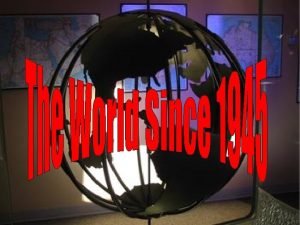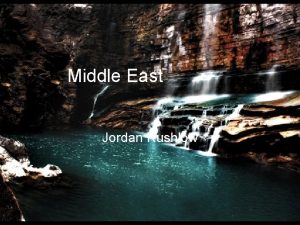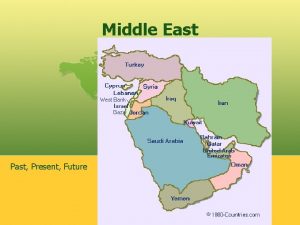Ancient Middle East Middle East Geography I The























- Slides: 23

-Ancient Middle East-

-Middle East Geography- I. The Middle East includes Southwest Asia and North Africa *Both have similar cultures

II. The Middle East is the meeting place of three continents A. Africa B. Asia C. Europe *Center of trade – “Cross roads of the world”

III. Desert – covers 90% of the Middle East A. Sahara – world’s largest B. Arabian Desert C. Deserts influence the culture of the Middle East 1. Clothing – light, loose cloth 2. Nomads – move from place to place 3. Housing – use clay, make tents

IV. Natural Resources A. 70% of the world’s oil reserves are in the Middle East 1. Most of the reserves are in Persian Gulf nations 2. The economies of these nations are dominated by the sale of oil

B. There is a lack of water in the Middle East 1. Only 7% of the land is arable a. Irrigation is essential

V. River Valleys A. The Tigris-Euphrates and the Nile are the two major river valleys in the area

B. They were the birthplace of civilization C. They provided transportation for trade D. The soil was fertile because of the silt left by annual floods and led to surplus agriculture

-River Civilizations of the Middle East. I. Civilizations are complex cultures with five characteristics

A. Advanced Cities – Cities are different from villages 1. Villages may be self-sufficient 2. Cities rely on trade

B. Specialized Workers: 1. Artisans – make goods by hand 2. Merchants – carryout trade 3. Soldiers

C. Complex Institutions 1. Formal government 2. Organized religion 3. Education system

D. Record Keeping E. Advanced Technology – Early civilizations used the wheel, plow, sailboat, and metal weapons

II. Sumer A. In about 3000 BC, the Sumerians built a great civilization in Mesopotamia 1. This was the area between the Tigris and Euphrates rivers 2. This region became known as the Fertile Crescent

B. The Sumerians built pyramid temples called Ziggurats C. Surplus crops were produced using irrigation ditches from rivers D. Scribes – professional record keepers – invented the world’s first system of writing called cuneiform E. Sumerians invented the wheel, the sail, and the plow

III. Babylonians succeeded the Sumerians in Mesopotamia A. Babylonians developed the Code of Hammurabi 1. Laws were written on stone tablets and placed throughout the empire 2. Class distinctions – different punishment for rich and poor 3. “Eye for an eye”

IV. Egyptians A. Gift of the Nile 1. The Nile flooded annually providing fertile soil for farming

B. Pyramids 1. Ancient Egyptians built giant temples for their dead pharaohs 2. They believed the dead king continued to rule after death 3. The dead pharaoh’s body was mummified and placed in a tomb within the pyramid C. Hieroglyphics – writing system of Ancient Egyptians

V. Phoenicians A. Located north of Palestine along the Mediterranean Sea B. Great sailors 1. Traveled and traded throughout the Mediterranean 2. They were known as the “carriers of civilization” C. Established colonies, including Carthage D. Major contribution to civilization was the alphabet

VI. Assyrians A. Conquerors who created the largest empire to date 1. Overran Phoenicia, Babylonia, Palestine and others B. Army used advanced techniques to defeat their enemies including iron-tipped arrows, swords and spears

C. First army to use cavalry – men on horseback 1. Cavalry and charioteers wore helmets and breastplates D. Terrorized conquered people – hated by their enemies E. First people to set up an effective system of governing an empire 1. The Assyrian empire lasted about 150 years

VI. Persians A. The Persian Empire extended for 3000 miles from Egypt to India 1. The empire lasted about 200 years B. It was a well-organized empire that was divided into provinces directed by a satrap (governor)

C. Built roads to connect the empire and help trade D. Allowed conquered people to retain their religion, laws and local customs E. Cultural Diffusion occurred between the various provinces F. Early concept of a heaven and hell 1. May have influenced Judaism and Christianity
 North american
North american Ethnic groups in the middle east
Ethnic groups in the middle east Is middle east in asia
Is middle east in asia Physical geography of middle east
Physical geography of middle east Ancient time ancient means of communication pictures
Ancient time ancient means of communication pictures Ancient india vs ancient china
Ancient india vs ancient china Early empires in the ancient near east
Early empires in the ancient near east The ancient near east
The ancient near east Ancient near east countries
Ancient near east countries Physical activities of the primitive society
Physical activities of the primitive society Ancient greece geography
Ancient greece geography Egypt and kush map
Egypt and kush map Roman republic geography
Roman republic geography Ancient greece geography
Ancient greece geography Geography of ancient greece map
Geography of ancient greece map Geography of ancient japan
Geography of ancient japan Ancient egypt civilization geography
Ancient egypt civilization geography Disadvantages of ancient egypt geography
Disadvantages of ancient egypt geography Describe the geography of ancient greece
Describe the geography of ancient greece China geography
China geography Geography of ancient greece
Geography of ancient greece Ancient rome climate and geography
Ancient rome climate and geography Ancient china deserts
Ancient china deserts Ancient rome outcomes geography and early republic
Ancient rome outcomes geography and early republic

